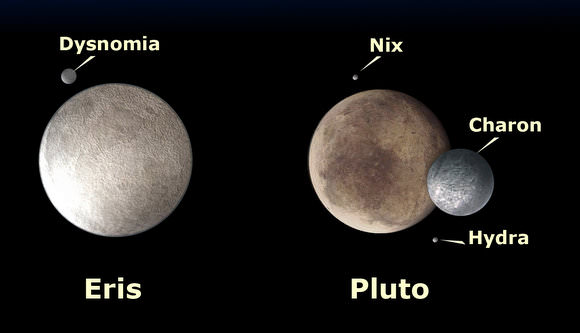[/caption]
Pluto, we hardly knew ya! Don’t worry, she’s not going anywhere. However, this once happy planet will no longer be listed amongst the “planets” in our solar system. According to International Astronomical Union (IAU), which began meeting in August of 2006, the term Plutoid now applies to Pluto, as well as any other small stellar body that exist beyond the range of Neptune. Arriving at this working definition in 2008, two years after first meeting, the IAU defines the term Plutoids thusly: “Plutoids are celestial bodies in orbit around the Sun at a semimajor axis greater than that of Neptune that have sufficient mass for their self-gravity to overcome rigid body forces so that they assume a hydrostatic equilibrium (near-spherical) shape, and that have not cleared the neighbourhood around their orbit.”
The reason the IAU began meeting in the first place was to iron out some ambiguities that exist in the terminology of astronomy. For example, thought some might find it shocking, astronomers had never actually come up with a definition of “planet”. Originally, a planet meant a “wandering star” – ie. a star that appeared to move from constellation to constellation. This was the definition used by ancient astronomers, and it applied to the sun and moon as well. However, Copernicus’s heliocentric model changed all that; now it was clear that the Earth was a planet itself and moved around the Sun with the rest of them. In addition, more and planets were being discovered beyond Jupiter, such as Uranus and Neptune, and then between Jupiter and Mars. This included Ceres, Pallas, Vesta, and Juno, but astronomers soon realized that these bodies were far too small to fit with the rest of the planets.
Then came Pluto’s discovery. At the time, scientists thought it to be several times larger than it actually was; accordingly they placed it on the list of planets. Eventually, its true size was realized and other bodies similar to Pluto in size and composition were found far beyond Neptune, in what is known as the Kuiper Belt. Pluto was to these stellar objects what Ceres was to large objects in the asteroid belt – that is to say, comparable in size. Astronomers proposed several names for these objects, but matters did not come to a head until Eris was discovered. This dwarf planet was actually larger than Pluto, 2500 km in diameter, making it twenty-seven percent larger than Pluto.
In the end, the IAU could only resolve this matter by removing Pluto from the list of planets and devising a new category for dwarf planets that could no longer be considered true planets. Plutoid was the result, and now applies to the trans-Neptunian objects of Pluto, Haumea, Makemake, and Eris.
We have written many articles about Plutoid for Universe Today. Here are some facts about Pluto, and here’s an article about why Pluto is no longer a planet.
If you’d like more info on Pluto, check out Hubblesite’s News Releases about Pluto, and here’s a link to NASA’s Solar System Exploration Guide to Pluto.
We’ve also recorded an episode of Astronomy Cast dedicated to Pluto. Listen here, Episode 64: Pluto and the Icy Outer Solar System.
Sources:
http://en.wikipedia.org/wiki/Plutoid
http://astroprofspage.com/archives/1685
http://www.sciencedaily.com/releases/2008/06/080611094136.htm
http://en.wikipedia.org/wiki/Eris_%28dwarf_planet%29

